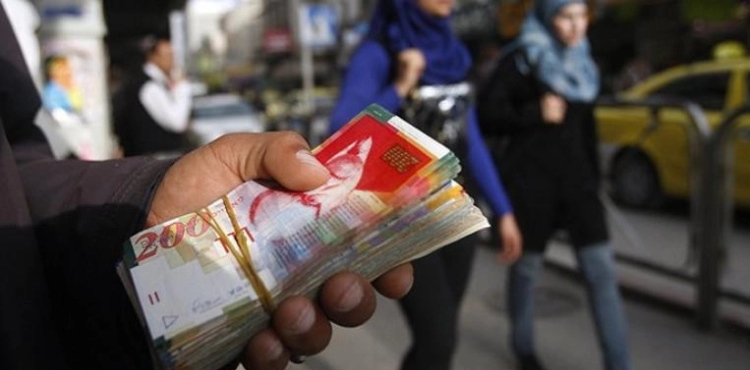The Monetary Authority has issued its annual report for 2018, which reviews the latest developments and developments in the global, regional and local economies, in addition to the financial developments of the government, the external sector and the Palestinian balance of payments, as well as developments in the financial sector, , The banking sector and non-bank financial institutions.
The Governor of the Monetary Authority, Azzam al-Shawa, said that the issuance of this report comes at a stage where the international and regional scene witnessed many economic and political changes, which caused more pressures and challenges on the Palestinian economy, and led to the retreat of many of its economic and social indicators.
In this context, the report showed that the slowdown in the Palestinian economy continued for the second year in a row, with an increase in 2018 (as predicted by the Monetary Authority earlier), with growth reaching 0.9% compared to 3.1% in 2017 (GDP) ($ 13.8 billion) as the economy in the Gaza Strip continues to contract and the growth momentum in the West Bank declines. In the Gaza Strip, growth fell by 6.9%, in addition to another decline of 12.5% ​​in 2017. While growth in the West Bank slowed to 3.1% from 8.5% in 2017.
Shawa added that the actual impact of this performance has been reflected in more than one aspect, especially per capita income, which fell 1.7% from its level in the world 2017, to $ 3,021. In the light of this performance, per capita income in the West Bank has not been able to grow by more than 0.8% (about $ 4,188), while income in the Gaza Strip has shrunk by 9.5%, to its lowest level ever ($ 1,431), About a third of the West Bank.
Although the economy did not suffer from any inflationary pressures at this level of performance, it was a price contraction. Consumer prices fell slightly by 0.2% (0.4% in the West Bank versus 1.3% in the sector). Has suffered from rising unemployment rates to record levels, where high unemployment remains one of the main challenges facing the Palestinian economy, especially in the Gaza Strip. Unemployment rates in Palestine rose to 30.8% of the total labor force, compared with 28.4% in 2017, due to the increase in the Gaza Strip from 44.4% in 2017 to 52.1% in 2018, and in the West Bank from 18.7% in 2017 to 17.6% In 2018.
In the area of ​​public finance, the Governor pointed out that the Palestinian government suffered a great deal of pressure during 2018 due to the significant decrease in revenues, whether related to clearing revenues or grants and foreign aid, which led to a decline in public revenues and grants by 4.1% Compared to the previous year (to reach NIS 15.3 billion). Despite the government´s attempts to mitigate the effects of this situation, by rationalizing public expenditure and its success in reducing this expenditure by 3.2% (to about NIS 14.1 billion), the result of these developments has been a rise in the total deficit before grants and assistance (on a cash basis) About NIS 1.7 billion, compared with a deficit of NIS 1.4 million in 2017, an increase of 22.9% over 2017.
In addition, the situation in 2018 resulted in the accumulation of new arrears on the government by about 514.8 million shekels, bringing the total arrears accumulated by the government at the end of 2018 about 12.7 billion shekels (equivalent to about 3.4 billion dollars, or 23.3% of GDP. Second, government public debt (denominated in US dollars) declined by 6.8% to reach $ 2.3 billion (about NIS 8.9 billion), or 16.2% of GDP.
The Governor of the Monetary Authority also noted the difficulty of the situation in the external sector and the balance of payments due to the increase in the current account deficit in the Palestinian balance of payments by about 6.1% to reach 1.7 billion dollars, constituting about 11.4% of GDP compared with 10.8% in 2017 .
In terms of the Monetary Authority and the banking sector, the Governor stated that despite the difficult political conditions and conditions in which we live, the Monetary Authority was able, during 2018, to achieve more achievements at the regulatory and legal level regulating the banking sector and its support of the various regulatory systems; And to strengthen its Arab, regional and international relations in order to deepen the links between the Palestinian banking system and its regional and international environment.
The results of these measures reflected positively on the vital indicators of the Palestinian banking sector. Banking sector assets increased by 1.7% to reach US $ 16.1 billion, while enhancing public confidence in the soundness and discipline of this sector in line with the highest international banking standards. The bank´s credit portfolio grew by 5.1% to reach US $ 8.4 billion and the banking sector´s equity continued to rise by 1.1% to reach US $ 12.2 billion. , To reach 1.9 billion d Lar.
As for the future prospects of the Palestinian economy, the Governor explained that the expectations of the Monetary Authority indicate that the slowdown in the economy will continue in the year 2019 to reach about 0.5% compared with 0.9% in 2018 (according to the basic scenario), mainly affected by the assumption of the continuation of the financial crisis suffered by The government against the backdrop of the crisis of the clearing with the Israeli side, and the continued decline in the volume of grants and foreign aid.
The annual report of the Monetary Authority is issued regularly by the Research and Monetary Policy Department, which is a basic reference for research institutions and those interested in the Palestinian economic affairs, because it contains an in-depth analysis based on the latest and most accurate data available.












